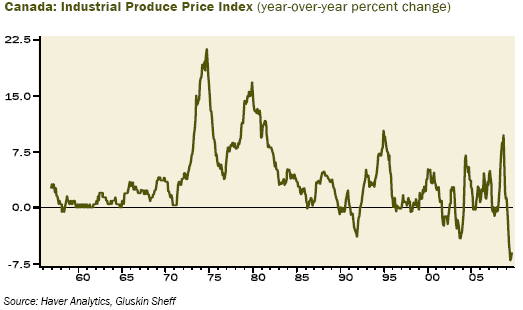Deflation seems to have become a serious prospect in Canada, as a 0.5% drop in prices in September (versus market expectations of a 0.2% decrease) reinforced fears of a downward spiral toward a period of falling prices that feeds on itself.
According to David Rosenberg, the country’s industrial product price index remains deep in deflation territory, down a near-record 6.1% in September. The drop will certainly add more pressure on the Bank of Canada which had projected only a brief period of falling prices.
PRODUCER PRICES IN CANADA CONFIRM DEFLATIONARY TREND

“Canada’s industrial product price index (IPPI), which is similar to the U.S.’s producer product index (PPI), surprised to the down side, falling 0.5% in September versus market expectations of a 0.2% decrease. Since May of this year, the month-over-month trend in IPPI has been very volatile, going up one month then reversing course the next month, so it is difficult to find a trend with these monthly gyrations. Of the 21 major groups, over 85% were either down or flat on the month and a measly 15% (or just three groups) managed to eke out an increase. Again, this attests to our deflationary and hence income-heavy tilt to our investment strategy.
On a year-over-year basis, IPPI remains deep in deflation territory, down a near-record 6.1% in September. Excluding the effects of energy, which declined 2.6% in September, IPPI was down 0.3% — the sixth consecutive monthly decline. Year-over-year the trend in IPPI, excluding energy, is at -2.1%, just a slight improvement from the -2.4% pace in August. Every stage of Canadian production is still in deflation mode — the raw materials purchase index down -21.4% YoY; prices for intermediate goods down 8.5% YoY – the ninth decline in a row, and finished goods are deflating at a 1.9% YoY rate.
The strong Canadian dollar is playing a supporting but not a dominant role here in terms of compounding this deflationary trend. As the Bank of Canada said in its latest policy announcement “persistent strength in the Canadian dollar” is going to “slow growth and subdue inflation pressures” and that seems to be the case. For September, the Loonie was up 0.6% versus the U.S., according to Statistics Canada, if the CAD remained unchanged, the IPPI would have declined 0.4% instead of sliding 0.5%.”
emphasis added
- Bulenox: Get 45% to 91% OFF ... Use Discount Code: UNO
- Risk Our Money Not Yours | Get 50% to 90% OFF ... Use Discount Code: MMBVBKSM
Disclaimer: This page contains affiliate links. If you choose to make a purchase after clicking a link, we may receive a commission at no additional cost to you. Thank you for your support!



Leave a Reply